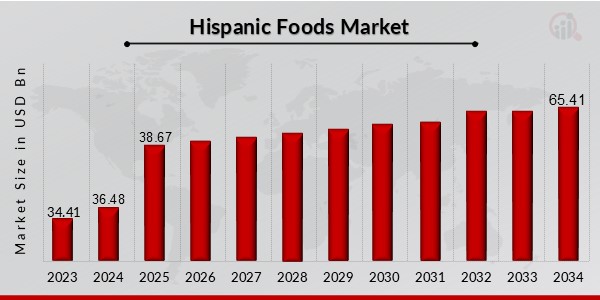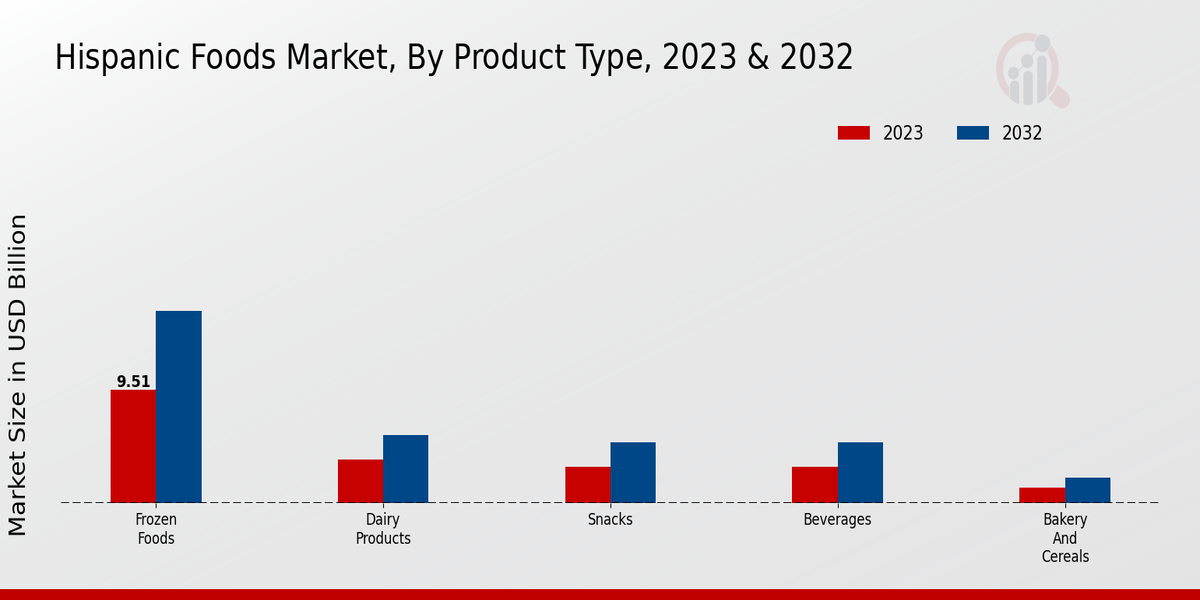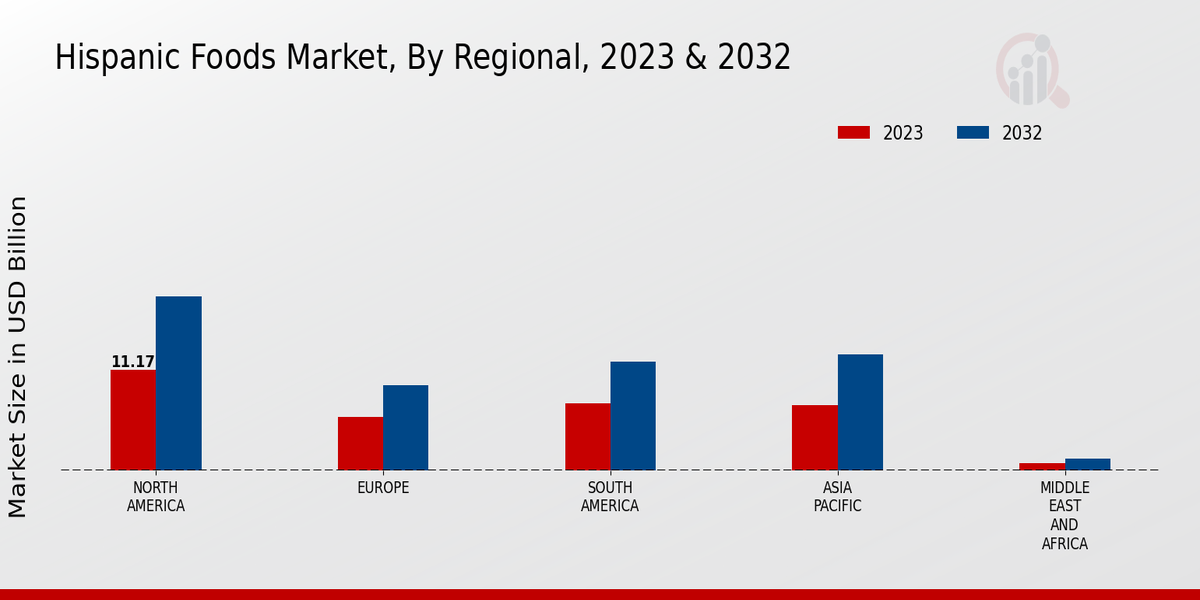Global Hispanic Foods Market Overview
Hispanic Foods Market Size was estimated at 36.48 (USD Billion) in 2024. The Hispanic Foods Industry is expected to grow from 38.67(USD Billion) in 2025 to 65.41 (USD Billion) by 2034. The Hispanic Foods Market CAGR (growth rate) is expected to be around 6.0% during the forecast period (2025 - 2034).

Source: Primary Research, Secondary Research, Market Research Future Database and Analyst Review
Key Hispanic Foods Market Trends Highlighted
The Hispanic Foods Market is experiencing significant growth driven by the rising demand for authentic and flavorful ethnic cuisines. The increasing Hispanic population in various regions, particularly in the United States, is fueling this demand. Moreover, evolving consumer preferences for healthier and natural food options are creating opportunities for innovative Hispanic food products.
Key market drivers include the growing popularity of Hispanic food among non-Hispanic consumers, as well as the demand for convenient and ready-to-eat meal options. Opportunities exist in the development of premium Hispanic products, expansion into international markets, and the integration of technology into the supply chain.
Recent trends in the Hispanic Foods Market include the rise of fusion dishes, blending traditional Hispanic flavors with other cuisines. There is also a growing focus on sustainability and ethical sourcing, with consumers seeking products that align with their values. Additionally, digital marketing and e-commerce platforms are playing a significant role in expanding the reach of Hispanic food brands and connecting with consumers.
Hispanic Foods Market Drivers
Growing Hispanic Population
The increasing Hispanic population in the United States is going to support the growth of the Hispanic foods market. According to the U.S. Census Bureau, the Hispanic population is expected to reach 111 million by 2060. Thus, the increasing Hispanic population is expected to increase the demand for Hispanic foods in the United States as they are more likely to consume Hispanic foods than other age groups.
Moreover, the increasing Hispanic population is also resulting in the growth of Hispanic-owned small businesses; this, too, is anticipated to be a driving factor for the Hispanic Foods Market.Demand for Hispanic cuisines is recorded in other countries, too; the increasing Hispanic population around the world and rising demand for Hispanic cuisines are also expected to support the growth of the Hispanic Foods Market Industry. Urbanization, change in lifestyle and rising disposable income also play a significant role in the demand for Hispanic foods. The increasing Hispanic population is also changing the way food is sold and marketed.
Companies are beginning to target the Hispanic population and are beginning to run special campaigns for them, considering their cultural preferences.Thus, the increasing Hispanic population combined with changing trends is expected to increase the demand for Hispanic foods.
Increasing Popularity of Hispanic Cuisine
There is no doubt that Hispanic cuisine is gaining in popularity among non-Hispanic consumers. For one thing, Mexican food is the most popular type of Hispanic cuisine in the United States. For another, various other Hispanic cuisines, such as Cuban, Puerto Rican, and Dominican, are also becoming increasingly popular. This is likely to be the main driver for the growth of the Hispanic food sector as non-Hispanic consumers are beginning to consume Hispanic foods more and more.
Expansion of Hispanic Food Products
The Hispanic food market is continuously growing and expanding as new products are being introduced constantly. This expansion is due to the increased demand for Hispanic foods and the growing number of Hispanic-owned businesses. Furthermore, more and more food companies are beginning to realize the potential of the Hispanic foods market and are also investing in new product development, which is expected to further drive growth in this market.
Hispanic Foods Market Segment Insights
Hispanic Foods Market Product Type Insights
The product type considered in The Hispanic Foods Market is segmented into Frozen Foods, Dairy Products, Snacks, Beverages, Bakery and Cereals, Meat, Poultry, Seafood, Dry Grocery, and Produce. Among these, Frozen Foods accounted for the most significant market share in 2023 and is expected to lead the market through 2032. It is being driven by the growing preference for convenience foods and the growing availability of frozen Hispanic foods. Dairy Products are another major segment of the Hispanic food market.
In 2023, Dairy Products had a substantial market share, and it is projected that the demand for Hispanic dairy products, such as cheese and yogurt, will continue to grow.
It will be supported by the increasing Hispanic population and their cultural attachment to Hispanic dairy foods. Snacks are another major segment of the Hispanic Foods Market. Snacks are a rapidly growing segment of the Hispanic Foods Market. Snacks have been growing on account of the rapidly increasing consumption of Hispanic snacks by the non-Hispanic population. In addition, the increasing demand for healthier and more convenient snacking items is also contributing to the growth of this segment.
Beverages also had a substantial market share in 2023.It will be supported by the growing Hispanic population and their rising reliance on Hispanic beverages, such as agues, frescas and horchata. Bakery and Cereals is a relatively small segment of the Hispanic food market, but it is expected to grow steadily. It is being driven by the increasing demand for Hispanic bakery products, such as pan dulce and tortillas. Meat, Poultry, and Seafood is another major segment of the Hispanic Foods Market. Meat, Poultry, and Seafood had a considerable market share in 2023.
Meat, Poultry, and Seafood products will be witnessing strong demand on the backdrop of the rising Hispanic population, especially among the Hispanics.
Dry Grocery is another relatively small segment of the Hispanic Foods Market, but it is expected to grow steadily. Dry Grocery is witnessing a growing demand for Hispanic dry grocery products, such as rice and beans. Finally, Produce also had a considerable market share in 2023 and is expected to grow steadily. It is being driven by the growing Hispanic population and their rising consumption of Hispanic produce. Product Type and the Leading Segment in The Hispanic Foods Market.

Source: Primary Research, Secondary Research, Market Research Future Database and Analyst Review
Hispanic Foods Market Distribution Channel Insights
The Hispanic Foods Market is categorized by distribution channel into retail stores, online marketplaces, restaurants, food service distributors, and convenience stores. In 2023, retail stores will be the leading distribution channel, generating nearly 60% of the Hispanic Foods Market’s revenue. The dominance of this segment is a consequence of the extensive presence of Hispanic grocery stores and supermarkets providing a wide range of Hispanic food products to consumers.
Online marketplaces have become an essential channel for Hispanic foods, as consumers increasingly prefer online grocery shopping and home delivery.Restaurants and food service distributors are also key to the distribution of Hispanic foods as the demand for Hispanic cuisine surges in the food service industry. Furthermore, convenience stores’ importance is growing as a distribution channel, allowing consumers to purchase Hispanic food items in urban areas where there is a significant Hispanic population.
Hispanic Foods Market Consumer Demographics Insights
The Hispanic Foods Market is segmented by consumer demographics, including Hispanic ethnicity, age, income, household size, and region. Hispanic Ethnicity: The Hispanic population in the United States is expected to reach 62 million by 2060, making it the largest minority group in the country. This growth is driving demand for Hispanic foods as more and more consumers seek out authentic and flavorful dishes.
Age: Hispanic consumers are younger than the general population, with a median age of 30. This younger demographic is more likely to experiment with new foods and flavors, which is driving demand for innovative Hispanic food products.Income: Hispanic households have a median income of $57,000, which is slightly lower than the general population. However, Hispanic consumers are more likely to spend a higher percentage of their income on food, as food is an important part of their culture.
Household Size: Hispanic households are larger than the general population, with an average of 3.5 people per household. This larger household size is driving demand for family-sized meals and products that are convenient for busy families.
Region (Within the Hispanic Market): The Hispanic population is not evenly distributed across the United States.The largest concentrations of Hispanics are found in California, Texas, Florida, and New York. This regional variation is reflected in the demand for Hispanic foods, as different regions have their own unique culinary traditions.
Hispanic Foods Market Packaging Type Insights
The Packaging Type segment of the Hispanic Foods Market is expected to exhibit dynamic growth in the coming years, driven by increasing consumer demand for convenience, extended shelf life, and enhanced product quality. Canned foods account for a significant share of the market, offering extended shelf life and ease of storage. Frozen foods, on the other hand, provide convenience and allow for the year-round availability of seasonal products.
Packaged foods, including snacks and ready-to-eat meals, cater to the growing on-the-go consumption trend.Fresh foods, such as fruits and vegetables, offer health benefits and appeal to consumers seeking natural and minimally processed options. Dried foods, including spices and herbs, add flavor and convenience to various Hispanic dishes. The Hispanic Foods Market segmentation provides valuable insights into the diverse packaging types used in the industry, enabling manufacturers to tailor their packaging strategies to meet evolving consumer needs and drive market growth.
Hispanic Foods Market Health and Wellness Trends Insights
Health and Wellness Trends continue to shape the Global Hispanic food market, with an increasing demand for products that promote well-being and cater to specific dietary needs. Organic products, with their perceived health benefits and environmental sustainability, hold a significant share of the market. Gluten-free options are gaining traction due to rising awareness of celiac disease and gluten intolerance.
Non-GMO products are also witnessing increasing demand as consumers become more conscious of the potential health risks associated with genetically modified ingredients.Reduced Sodium and Low-Sugar products are gaining popularity as consumers seek healthier alternatives to traditional Hispanic foods, which are often high in sodium and sugar. The Hispanic Foods Market revenue from these Health and Wellness Trends is projected to grow steadily in the coming years, driven by the growing health consciousness among consumers.
Hispanic Foods Market Regional Insights
The regional segmentation of the Hispanic Foods Market offers valuable insights into the market's geographical distribution and growth dynamics. North America holds a significant share of the market, driven by the large Hispanic population in the United States. The region is expected to maintain its dominance over the forecast period, with a projected revenue of USD 22.4 billion by 2024. Europe follows as the second-largest regional market, with countries like Spain, France, and the United Kingdom contributing to its growth.
The market in APAC is projected to witness steady growth, with emerging economies like India and China driving demand.South America and MEA represent promising markets with untapped potential, offering opportunities for expansion. The Hispanic Foods Market segmentation provides comprehensive data and insights, enabling businesses to make informed decisions and target specific regions for growth.

Source: Primary Research, Secondary Research, Market Research Future Database and Analyst Review
Hispanic Foods Market Key Players And Competitive Insights
Major players in the Hispanic Foods Market are constantly striving to gain a competitive edge in the industry through strategic initiatives such as product innovation, expansion into new markets, and mergers and acquisitions. Leading Hispanic Foods Market players are focusing on developing innovative products that cater to the evolving tastes and preferences of consumers. Expanding into new markets, both domestically and internationally, is another key strategy employed by companies to drive growth. Additionally, mergers and acquisitions allow companies to consolidate their market position, acquire new technologies, and expand their product portfolios.
Hormel Foods Corporation, a leading company in the Hispanic Foods Market industry, has a strong presence in the Mexican food category. The company's portfolio includes well-known brands such as Chi-Chi's, Herdez, and La Victoria. Hormel Foods has a wide distribution network and a strong brand reputation, which has contributed to its success in the Hispanic Foods Market. The company is committed to innovation and has introduced new products such as Chi-Chi's Queso Fundido and Herdez Salsa Verde to meet the evolving demands of consumers.
Campbell Soup Company, a competitor in the Hispanic Foods Market, has a significant presence in the soup and salsa categories. The company's portfolio includes brands such as Campbell's, Prego, and Pace. Campbell Soup Company has a strong focus on innovation and has introduced new products such as Campbell's Cantina Style Soups and Prego Farmers' Market Salsa to cater to the growing Hispanic consumer base. The company has also expanded its distribution into new markets, both domestically and internationally, to drive growth.
Key Companies in the Hispanic Foods Market Include
Hispanic Foods Market Industry Developments
The Hispanic Foods Market is projected to reach USD 54.9 billion by 2032, exhibiting a CAGR of 6.01% during the forecast period (2024-2032). The growth is attributed to the increasing Hispanic population in the US, rising disposable income, and growing popularity of Hispanic cuisine. Recent developments include the launch of new Hispanic food products by major food companies such as Kraft Heinz and General Mills. Additionally, the growing popularity of online grocery shopping is providing new opportunities for Hispanic food brands to reach consumers.
Hispanic Foods Market Segmentation Insights
-
Hispanic Foods Market Product Type Outlook
- Meat, Poultry, and Seafood
-
Hispanic Foods Market Distribution Channel Outlook
-
Hispanic Foods Market Consumer Demographics Outlook
- Region (Within the Hispanic Market)
-
Hispanic Foods Market Packaging Type Outlook
-
Hispanic Foods Market Health and Wellness Trends Outlook
-
Hispanic Foods Market Regional Outlook
| Report Attribute/Metric |
Details |
| Market Size 2024 |
36.48(USD Billion) |
| Market Size 2025 |
38.67(USD Billion) |
| Market Size 2034 |
65.41(USD Billion) |
| Compound Annual Growth Rate (CAGR) |
6.0% (2025 - 2034) |
| Report Coverage |
Revenue Forecast, Competitive Landscape, Growth Factors, and Trends |
| Base Year |
2023 |
| Market Forecast Period |
2025 - 2034 |
| Historical Data |
2019 - 2023 |
| Market Forecast Units |
USD Billion |
| Key Companies Profiled |
Bimbo Bakeries USA, Conagra Brands, Pilgrim’s Pride, General Mills, Campbell Soup Company, McCormick Company, JBS, Tyson Foods, Kraft Heinz, Nestle, Mondelez International, Kellogg Company, PepsiCo, Hormel Foods, Grupo Bimbo |
| Segments Covered |
Product Type, Distribution Channel, Consumer Demographics, Packaging Type, Health and Wellness Trends, Regional |
| Key Market Opportunities |
1 Growing Hispanic population increasing demand for authentic cuisine2 Rising health consciousness demand for healthier Hispanic food options3 Expanding retail presence and wider availability of Hispanic food products4 Growing popularity of Hispanic food in no Hispanic households |
| Key Market Dynamics |
Growing Hispanic population Increasing demand for authentic flavors Health consciousness Ecommerce expansion Product innovation. |
| Countries Covered |
North America, Europe, APAC, South America, MEA |
Frequently Asked Questions (FAQ):
The Hispanic Foods Market was valued at approximately USD 38.67 billion in 2025 and is projected to grow to USD 65.41 billion by the year 2034, exhibiting a CAGR of 6.0% during the forecast period (2025-2034).
North America currently dominates the Hispanic Foods Market and is expected to continue its dominance throughout the forecast period. The region's large Hispanic population and growing demand for authentic Hispanic cuisine are the key drivers of market growth in this region.
The snacks segment is projected to grow at the highest CAGR during the forecast period. The increasing popularity of Hispanic snacks, such as tortilla chips, salsa, and dips, is driving the growth of this segment.
The major players in the Hispanic Foods Market include Mondelez International, Inc., PepsiCo, Inc., Nestle S.A., General Mills, Inc., and The Kraft Heinz Company. These companies offer a wide range of Hispanic food products, including snacks, beverages, dairy products, and meals.
The growing Hispanic population, increasing demand for authentic Hispanic cuisine, and rising disposable income are the key factors propelling the growth of the Hispanic Foods Market.
The challenges faced by the Hispanic Foods Market include intense competition, fluctuating raw material prices, and changing consumer preferences.
The growing popularity of Hispanic cuisine, increasing demand for healthy and convenient food options, and expanding distribution channels present significant growth opportunities for the Hispanic Foods Market.
The COVID-19 pandemic has had a significant impact on the Hispanic Foods Market, leading to disruptions in supply chains, changes in consumer behavior, and economic uncertainty. However, the market is expected to recover post-pandemic and continue its growth trajectory.
The key trends shaping the Hispanic Foods Market include the growing popularity of plant-based Hispanic foods, the increasing demand for clean-label products, and the rise of e-commerce.
The future prospects for the Hispanic Foods Market are positive, with the market expected to continue its growth trajectory over the next decade. The growing Hispanic population, increasing demand for authentic Hispanic cuisine, and rising disposable income are expected to drive the market's growth.

















